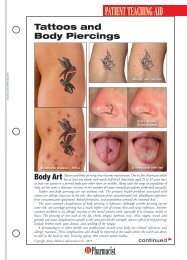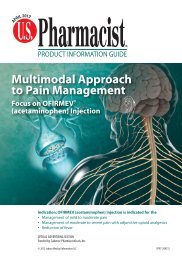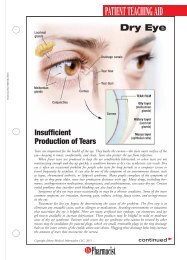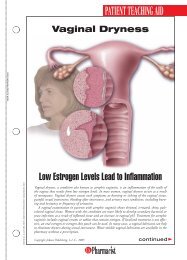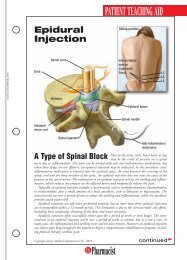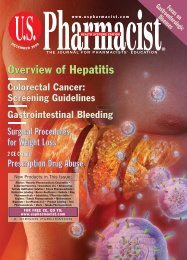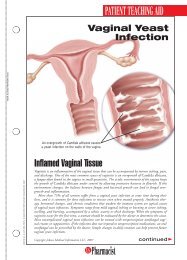View PDF Edition - U.S. Pharmacist
View PDF Edition - U.S. Pharmacist
View PDF Edition - U.S. Pharmacist
Create successful ePaper yourself
Turn your PDF publications into a flip-book with our unique Google optimized e-Paper software.
WHAT IS THE APPROPRIATE ANTIDEPRESSANT?Table 1Selective Serotonin Reuptake InhibitorsMedications Initial/Max Dose Comments Adverse EffectsCitalopram 20 mg/60 mg daily t 1/2= 35 h; weak CYP2D6 inhibitor; anxiety symptoms(Celexa) (40 mg max effective) significantly improved compared to other SSRIsEscitalopram 10 mg/20 mg daily t 1/2= 35 h; most potent SSRI;(Lexapro) (10 mg max effective) like citalopram, fewer drug interactionsFluoxetine 20 mg/80 mg daily Long t 1/2= 7-15 days; active metabolite norfluoxetine;(Prozac)potent CYP2D6 inhibitor = drug interactions;may cause weight lossFluvoxamine 50 mg/300 mg in t 1/2= 16 h adults, 26 h elderly; potent CYP3A4, 2C19,(Luvox) divided doses 1A2 inhibitor = most drug interactions; primarilyused to treat OCD and panic disordersParoxetine 20 mg/60 mg daily t 1/2= 26 h; potent CYP2D6 inhibitor; mild affinity for(Paxil) (50 mg max effective) muscarinic receptors = more anticholinergic sideeffects than other SSRIs; sedatingSertraline 50 mg/200 mg daily t 1/2= 26 h; absorption increases when taken with food;(Zoloft)weak CYP2D6 inhibitor = less potential drug interactions;more likely than other SSRIs to cause nausea; mostcited reason for d/cWeight gain,insomnia,tremors,prolonged QTinterval, dizziness,constipation, drymouth, nausea,lightheadedness,syncope,confusion,agitation, sexualdysfunctiond/c: discontinuation; max: maximum; OCD: obsessive compulsive disorder; SSRI: selective serotonin reuptake inhibitor; t 1/2: half-life.Source: References 4, 10.may be decreased in patients with depression, thus associatinga decreased amount of neurotransmitters withthe disorder. 8 The pharmacotherapy rationale hasbeen to boost these deficiencies by blocking the reuptakeor preventing enzymatic metabolism of neurotransmittersvia antidepressants. Overall, these mechanismsaim at increasing the level of neurotransmitters eitherby forcing the neuron to fire more often and producemore neurotransmitters or by preventing degradationof the neurotransmitter itself.Pharmacologic AgentsSeveral classes of agents are currently available to treatdepression. They include selective serotonin reuptakeinhibitors (SSRIs), tricyclic antidepressants (TCAs),monoamine oxidase inhibitors (MAOIs), and serotoninnorepinephrinereuptake inhibitors (SNRIs), amongothers.Antidepressants have been associated with an increasedrisk of suicidal thinking and suicidality in children, adolescents,and young adults in short-term placebo controlledstudies of MDD. Anyone considering the useof any antidepressant in a child, adolescent, or youngadult must balance this risk with the clinical need. Shorttermstudies did not show an increase in the risk of suicidalitywith antidepressants compared to placebo inadults beyond age 24 years, and there was a reductionin risk with antidepressants compared to placebo inadults aged 65 years and older. Depression and otherpsychiatric disorders are themselves associated withincreased risk of suicide. Patients of all ages who arestarted on antidepressant therapy should be monitoredappropriately and observed closely for clinical worsening,suicidality, or unusual changes in behavior. 9Selective Serotonin Reuptake Inhibitors 4,10 : SSRIs areconsidered first-line agents when it comes to treatingpatients with depression. These drugs include citalopram,escitalopram, fluoxetine, fluvoxamine, paroxetine,and sertraline (TABLE 1). The major adverse effectsof this class include nausea, vomiting, and diarrhea,which are dose-dependent effects and tend to dissipateafter the first weeks of treatment. In some patients,SSRIs can cause agitation and sleep disturbances, whichwill also dissipate with time. Sexual dysfunction is aside effect present with all antidepressants, but seemsto be most common with SSRIs.Serotonin syndrome (i.e., abdominal pain, diarrhea,sweating, mental status change, renal failure, cardiovascularshock, and possibly death) is a rare adverse effectof SSRIs. Serotonin syndrome can occur with an increasein SSRI dose or by taking SSRIs with herbals such asSt. John’s wort or with illicit drugs. Finally, combiningSSRIs with MAOIs can also lead to lethal drug interactionswith development of serotonin syndrome. Whenclinicians feel the need to switch from one class of agentto the other, it is suggested that at least five half-liveselapse between the time the SSRI is stopped and theMAOI is started. 4 Of all agents in the class, fluvoxaminehas the highest rate of drug interactions, since it29U.S. <strong>Pharmacist</strong> • November 2009 • www.uspharmacist.com




